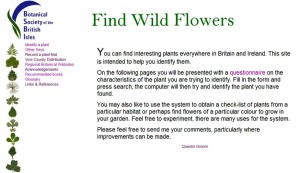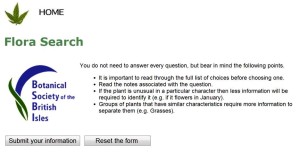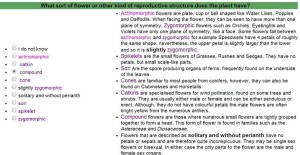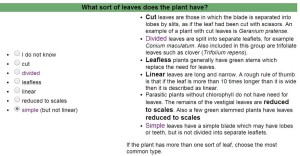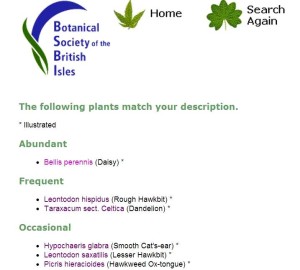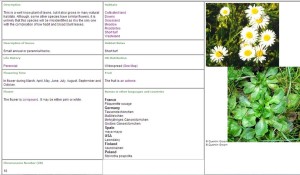This key is listed by BSBI (Botanical Society of the British Isles) as “A free and easy online key for beginners, by Quentin Groom“. So here, Dr M gives it the once over. It is undeniably free, but is it easy? And, more importantly, is it accurate and useful?
After an introduction from the author “Find Wild Flowers” there is a brief guide to using the key “Flora Search“.
There follows a series of questions which you try to answer by examining your plant carefully. If you can’t answer a question (e.g. you might not know which family it belongs to or which habitat it grows in if you didn’t collect it yourself) you can state “I do not know“. Obviously the more questions answered the more accurate the answer, but this “I do not know” option does mean you can get a list of suggestions for your plant even without a complete set of answers.
Dr M checked the key with a plant of the common Daisy – Bellis perennis which he found growing in a neaby lawn. Some example questions plus answers appropriate to the common Daisy are given below for illustration.
What family is it in? = Asteraceae. It can be very useful if you know which family your plant belongs to as this reduces the options considerably. This is why Dr M is so keen on teaching recognition of plant families as a fundamental plant ID skill!
What habitat was it growing in? = Dr M selected grassland from the range of habitats in the drop down list, as this was where he found the Daisy plant, though Daisies are found in plenty of other habitats too and Dr M assumes that this key has a range of habitats built in to take account of this variation for plant which occur in multiple habitats.
What sort of plant is it? There are several offered and Dr M selected the most appriate for his plant which was herb (i.e. a non-woody perennial plant).
In what month does it flower? = Dr M noted August, but Daisies can flower in many months of the year, and again presumably the key has a range of flowering times built in to take account of this variation.
What colour are the flowers? = This was a tricky one as Daisy’s have white AND yellow flowers in the same plant, but the key does not allow multiples answers to be selected, but Dr M put yellow in for this example.
What sort of flower does it have? A number of options are given here and you need to read the guidance notes carefully to check (e.g. regular or irregular flowers). But you definitely need to know that Daisies, and all Asteraceae, have many tiny flowers in a capitulum (in this key called a compound inflorescence) so Dr M selected compound!
How are the leaves arranged? Again a number of options give, e.g. opposite or alternate or in a rosette, Daisies are classic rosette plants, so Dr M selected leaves arranged in a rosette!
Are the leaves hairy? = You need to check with the trusty 10x hand lens, and Dr M confirmed yes, the leaves are slightly hairy!
What sort of leaves does it have? Again several options offered for cut, divided or simple leaves among others, and Dasies have undivided, spoon-shaped leaves and Dr M selected simple (but not linear) leaves from the available options.
Is the margin of the leaf entire or toothed or more deeply lobed? = Again Dr M checked with the hand lens, and saw that the leaf margin of the Daisy is not completely entire, but is rather shallowly toothed.
How big is the leaf? = Dr M measured about 3 cm, but this can vary and I assume the key has a range of sizes built in to take account of this variation.
Are there stipules present? = No, stipules are not present in Asteraceae (but Dr M reminds you that stipules are characteristic of several families including Fabaceae, Rosaceae and Geraniaceae for example).
Do the leaves have a stalk? (petiole) = Yes, the Daisy leaves are stalked!
Once Dr M had answered all the questions as accurately as he could (and there are hints provided of the kind of things to watch out for) he clicked “submit your information” and the result was a list of exact and close matches.
In this case we get a confident identification of Daisy (Bellis perennis) but also a list of other possibilities, in this case all things which show similarities with the Daisy, especially other examples of yellow Asteraceae (Dandelion, Hawkbit etc). If we had put “white” for flower colour maybe the list would have contained some white flowered Asteraceae? Why not check this out yourself and see?
As with any key, the solution is only a step on the way to a confident identification, and you should always check against descriptions in the fact sheets provided on this site and with other wild flower guides and floras such as the Book of Stace. You should also check some of the other suggested plants to be as confident as you can be that you have the right answer.
Dr M’s verdict: Well Dr M keyed out Common Daisy OK! But further road testing needed with his botany students to get a better feel for the accuracy and value of this online key.


